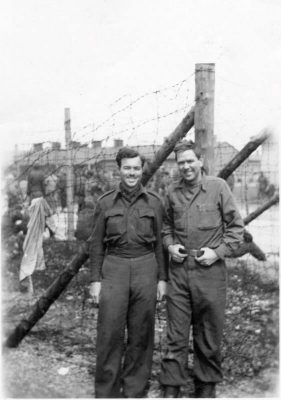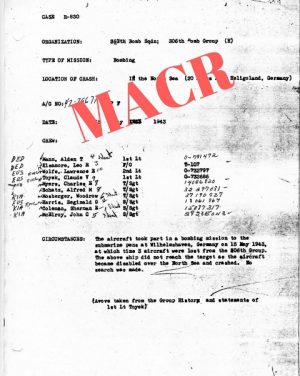22 Nov 306th BG MACRs
For the past couple of months, I have been helping the 306th Bomb Group Historical Association index names from the 1942-1945 MACRs, Missing Air Crew Reports.
The MACR was devised to record the important facts of the last known circumstances regarding missing air crews, those that did not return back to their bases. An official form was adopted in June of 1943.
In its archives, the Bomb Group Association has, if not the official MACR form, a document which records each crew member, ideally with the airman’s rank, position on the plane, serial number, and sometimes, his fate.
For each mission, I record the men’s information on a spreadsheet that can be uploading into the website’s search mechanism. At the same time, I look up what was written about the fateful day in First Over Germany: A History of the 306th Bombardment Group by Russell A. Strong, the book that follows, sometimes daily, the 306th’s activities at Thurleigh Airfield.
It has been an emotional experience to read what happened to each crew that didn’t return home. I envision the terror of these very young men in the nose, in the cockpit, in the body of the plane. I think about how close the crew of my Dad’s plane came to having some of the same terrible outcomes.
As I worked on yesterday’s MACR, I learned that the bombardier was the father of one of the contributors of the Facebook group, 306th Bomb Group – First Over Germany. (If you have any connection to the 306th, I recommend you join our group.)
On 15 May 1943, the 306th BG sent 24 planes and the 94th sent 13 to the naval base and submarine construction works at Wilhelmshaven, Germany. Weather prevented bombing the primary target. Bombs were dropped instead on secondary targets, and more than 100 enemy fighters rose to attack the bombers. The B-17s had no fighter support that day. It was a little too early in the war for them to be able to depend on that layer of protection.
The first plane to go down was with the 306th’s 367th Squadron, a B-17 piloted by 1st Lt. Alden T. Mann. Me 109s, Fw 190s, and antiaircraft attacked Alden’s plane. A German 20mm round exploded in the flight deck, instantly killing the co-pilot, F/O Leo R. Kissamore. Shrapnel from that round hit the oxygen bottles on the flight deck, causing an explosion. As the plane went down, the entire inside of the plane was afire.
Bombardier 1st Lt. Claude V. Toyek, who suffered broken ribs and minor burns, was able to help the badly burned pilot bail out. Parachuting with them was navigator 2nd Lt. Lawrence E. Wolfe and S/Sgt. Reginald G. Harris, a gunner. They were picked up from the North Sea by a Danish fishing boat, then were taken prisoner by the Germans.

At liberation: Larry Wolfe and, on the right, S/Sgt. Earl Highly from the 14th Division. Earl’s brother Oran, a member of the liberating force that entered the camp, found his brother there. (photo from Lt. Oran Highley)
The pilot died several days later in a German hospital. The navigator stayed in a hospital for six weeks before being moved to Stalag Luft 3 where he joined the bombardier. This is where they stayed until the end of the war.
As an enlisted man, S/Sgt. Harris was sent to Stalag 17B at Krems Camp in Austria, described in this magazine article as a “fleabag patch of Hell.” The next day after the mission, May 15, was to be Harris’s wedding to a Bedford girl.
Others who died in the inferno were T/Sgt. Charles E. Meyer, T/Sgt. Alfred M. Schatz, T/Sgt. Woodrow Mosbarger, S/Sgt. Sherman E. Coleman, and S/Sgt. John C. McElroy.
The 367th Squadron lost three planes that day and was sadly living up to the nickname the Saturday Evening Post magazine had branded them with … the “Clay Pigeon Squadron”. That name stuck and is now spoken with reverence.
After this mission, the 306th commander sent out a commendation to the group for their outstanding accomplishments despite the fact that “well over one-half of all crews who have been lost in action in this theatre were lost before they completed their first five missions.”
This has been a long post, I know, but I want to honor these young men who went through hell on May 15, 1943. As I go through the MACRs and the names of so many boys who died that day, I wonder if I am the last person who might record their names. Mann, Kissamore, Meyer, Schatz, Mosbarger, Coleman, McElroy. It’s been 73 years.
I wish their families could know how much we in the 306th Bomb Group Historical Association want them to be remembered.



Barbara Davis
Posted at 07:55h, 23 NovemberWow….. thanks Pat for all you do.
Gail Joyce
Posted at 10:58h, 02 AprilWoodrow Mosbarger was my grandfather. I have been looking for information about him for years and this is the most I’ve ever found. Thank you for this. I would love to find a photo of him to know what he looked like. I have asked relatives, but no one has any.
Pat DiGeorge
Posted at 11:59h, 02 AprilGail, there isn’t a photograph of the Mann crew on the 306th BG site, but I’ll ask the son of the bombardier to see if he has any crew photos.
Rebekah Mullins
Posted at 22:21h, 09 FebruarySHERMAN E. COLEMAN WAS MY GREAT UNCLE HE WAS ONLY 18 WHEN HE WAS KILLED THANK YOU FOR THIS!!
Pat DiGeorge
Posted at 06:05h, 10 FebruaryRebekah, thank you so much for your comment. It means a lot that a family member found my post.